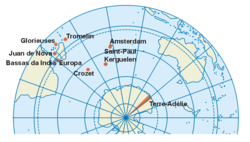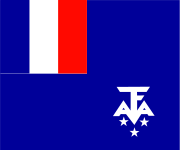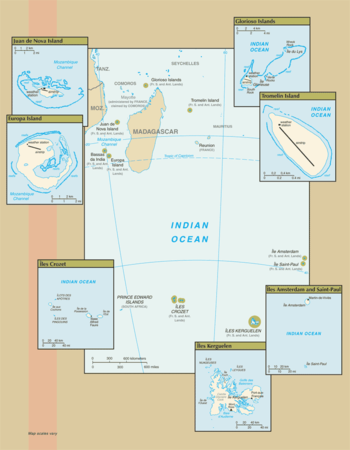French Southern and Antarctic Lands
2008/9 Schools Wikipedia Selection. Related subjects: Antarctica
| Territoire des Terres australes et antarctiques françaises (TAAF) Territory of the French Southern and Antarctic Lands
|
||||||
|---|---|---|---|---|---|---|
|
||||||
| Motto: " Liberté, Égalité, Fraternité" | ||||||
|
Click on map to enlarge
|
||||||
| Capital | Port-aux-Français | |||||
| Official languages | French | |||||
| Government | ||||||
| - | Prefect | Éric Pilloton | ||||
| Territoire d'outre-mer | ||||||
| - | Date | 1955 | ||||
| Area | ||||||
| - | Total | 439,781 km² 169,800 sq mi |
||||
| Population | ||||||
| - | estimate | 140 hab. | ||||
| Internet TLD | .tf | |||||
| Flag of the French Southern and Antarctic Lands: see CIA World Factbook | ||||||
The French Southern and Antarctic Lands (French: Terres australes et antarctiques françaises, abbreviated TAAF), full name Territory of the French Southern and Antarctic Lands (French: Territoire des Terres australes et antarctiques françaises), consist of:
- a group of volcanic islands in the southern Indian Ocean, southeast of Africa, approximately equidistant between Africa, Antarctica and Australia;
- Adélie Land, the French claim on the Antarctica continent under the Antarctic Treaty System;
- the Scattered islands in the Indian Ocean.
The territory is also often called the French Southern Territories (French: Terres australes françaises), which excludes Adélie Land where French sovereignty is not recognized internationally. The lands are not connected to France Antarctique, a former French colony in Brazil.
Administration
The French Southern and Antarctic Lands have formed a territoire d'outre-mer (an overseas territory) of France since 1955. Formerly, they were administered from Paris by an administrateur supérieur assisted by a secretary-general; since December 2004, however, their administrator has been a préfet, currently Éric Pilloton, with headquarters in Saint-Pierre on Réunion Island.
The territory is divided into five districts:
| District | Capital | Winter Population | Summer Population | Area (km²) |
EEZ (km²) |
|---|---|---|---|---|---|
| Îles Saint Paul et Amsterdam | Martin-de-Viviès | 25 | 45 | 61 | 502533 |
| Archipel Crozet | Alfred Faure | 25 | 45 | 352 | 567475 |
| Archipel des Kerguelen | Port-aux-Français | 70 | 110 | 7215 | 563869 |
| Terre Adélie | Dumont d'Urville Station | 30 | 110 | 432000 | - |
| Îles Éparses(1) | - | 56 | 56 | 38,6 | 593276 |
| TAAF | Saint-Pierre | 150 | 310 | 439781 | 2274277 |
(1)According to new law 2007-224 of February 21, 2007 Scattered Islands constitute the 5th district of TAAF . The website of the TAAF do not mention their population. The data are not included in the totals.
Each district is headed by a district chief, which has powers similar to those of a French mayor (including recording births and deaths and being an officer of judicial police).
Because there is no permanent population, there is no elected assembly, nor does the territory send representatives to the national parliament.
Geography
The territory includes Île Amsterdam, Île Saint-Paul, Îles Crozet, and Îles Kerguelen in the southern Indian Ocean near 43°S, 67°E, along with the French-claimed sector of Antarctica, Adélie Land, named by French explorer Jules Dumont d'Urville after his wife.
The "Adélie Land" of about 432,000 km² and the islands, totalling 7781 km², have no indigenous inhabitants, though in 1997 there were about 100 researchers whose numbers varied from winter (July) to summer (January).
Île Amsterdam and Île Saint-Paul are extinct volcanoes; the highest point in the territory is Mont Ross on Îles Kerguelen at 1850 meters. There are no airstrips on the islands and the 1232 kilometres of coastline have no ports or harbours, only offshore anchorages.
The islands in the Indian Ocean are supplied by the special ship Marion Dufresne sailing out of Le Port in Réunion Island. Terre Adélie is supplied by Astrolabe sailing out of Hobart in Tasmania.
However, the territory has a merchant marine fleet totalling (in 1999) 2,892,911 GRT /5,165,713 metric tons of deadweight (DWT), including seven bulk carriers, five cargo ships, ten chemical tankers, nine container ships, six liquefied gas carriers, 24 petroleum tankers, one refrigerated cargo ship, and ten roll-on/roll-off ( RORO) carriers. This fleet is maintained as a subset of the French register that allows French-owned ships to operate under more liberal taxation and manning regulations than permissible under the main French register. This register, however, is to vanish, replaced by the International French Register (Registre International Français, RIF).
Economy
The territory's natural resources are limited to fish and crustaceans; economic activity is limited to servicing meteorological and geophysical research stations and French and other fishing fleets.
The main fish resources are Patagonian toothfish and spiny lobster. Both are poached by foreign fleets; because of this, the French Navy and occasionally other services patrol the zone and arrest poaching vessels. Such arrests can result in heavy fines and/or the seizure of the ship.
France used to sell licences to fish the Patagonian toothfish to foreign fisheries; because of overfishing, it is now restricted to a small number of fisheries from Réunion Island.
The territory takes in revenues of about $18 million a year.
Marion Dufresne can host a limited number of fee-paying tourists, who will be able to visit the islands as the ship calls.
Miscellany
The French Southern Territories (i.e. excluding Adélie Land) is given the following country codes: FS ( FIPS) and TF ( ISO 3166-1 alpha-2).




